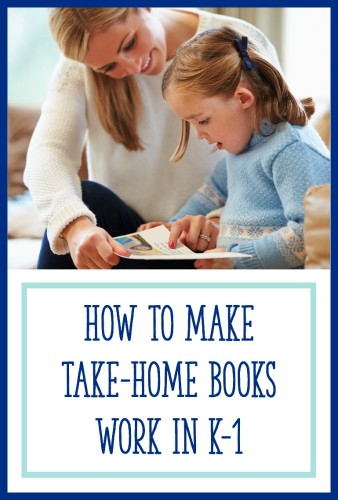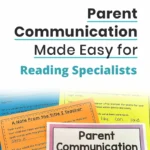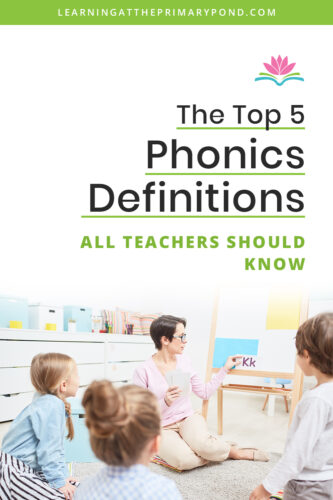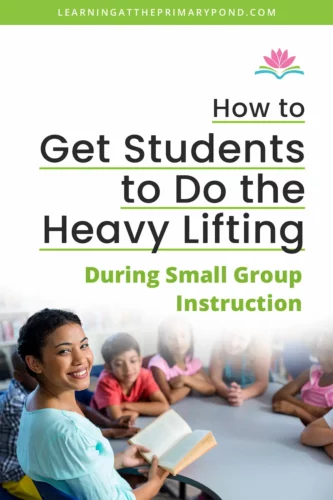Ah, take home books. Do you break out in a cold sweat at the very thought of letting kids take books home? I used to feel the same way!
However, giving kids books to have at home is super important! As you already know, many of our students don’t have books at home. And even those who do have books at home may not have new ones to read all the time. Growing up, my mom stayed at home with us and had time to take us to the library every 2 weeks or so. However, working parents may not have time for regular library trips. Wouldn’t it be best if kids could have access to books no matter what their home situation is?
Once I realized how important it is for kids to be able to take books home, I figured out some strategies to make the process smooth and stress-free. In this post, I’ll share some tips that worked for me – and I hope you’ll share your own tips in the comments!

Tip #1: Stick to a regular schedule – but that doesn’t mean kids have to take books home all the time!
Although I let students in 2nd grade and up take home books of their choice every night, I usually give younger kiddos a book (or a couple of books) for an entire week. I send home the book(s) in a baggie on Monday, and it must come back on Friday. This consistency makes it easier for parents to remember to send the books back.
I have kids keep books at home for a week for two reasons: 1) Kindergarteners and first graders really love reading and rereading books. Having a book at home for an entire week provides time for that to happen. 2) K-1 kiddos tend to be a little…shall we say…less responsible than older kids. 🙂 It’s easier on them (and you) to have to return books less often.
Also, even if you choose to send books home on Monday, this doesn’t mean that you have to send books home with every kid, every Monday! If you know that it’ll be difficult for you to make this happen every week, why not send home books every other week? Or send home half of the class with books one week, and then the other half the next? Alternating or rotating schedules are better than not sending home books at all.
Tip #2: Create an easy method of accountability to keep track of books.
One of the reasons that I was initially hesitant to send books home was the fear of them being lost. And, I mean, that fear isn’t unwarranted…I have definitely lost some books over the years! But as I’ve said in other blog posts, having to replace a $5 book is more than worth giving kids the opportunity to have books at home (in my opinion).
One way to create an accountability system would be to use library pockets. Place a pocket in the front of each book, and an index card with the book title within that pocket. Then, adhere one library pocket per child (labeled with their names) to a piece of poster board or a bulletin board. When kids take books home, they remove the index cards from their books and place them in their name pockets. When books come back, they take out the index cards and place them back in their books. This system ensures that you know which kid has which book (you’ll want to closely supervise the process, of course!). You’ll also be able to quickly see which students did not bring back their books.
Something else I’ve done (with Kindergarten) is designated a set of picture books (20-30, or more if possible) to serve as take-home books for the entire year. I made a list of the books and then rotated kids through the books on a weekly basis. Each week, I put one or two of the books in a plastic baggie and sent it home. I kept track of which book each child had, so when they were returned I could quickly figure out if any were missing. Having this separate set of take home books was very do-able for me, even during the year when I was finishing grad school, getting married, and buying a house in the span of 6 months. 🙂
Tip #3: Have “missing book” notes copied and ready to go.
This tip is pretty simple and may seem a little obvious. But when a book goes missing, it’s easiest if you can quickly fill in the title of a book and hand out the pre-written note. It makes your life easier and also helps ensure that you don’t let too much time pass before notifying parents about the missing book. You can grab some ready-to-go parent notes by clicking here.
Tip #4: Consider sending home books that don’t have to be returned at all.
Yes, it’s great to send home beautiful picture books for families to enjoy. But books that can be printed or copied work great, too! When you use reproducible books, not only do you not have to deal with missing books, but you are also giving kids books that they can keep and read over and over again.
One fun way to start your “take home and keep at home” book program is by having kids decorate shoeboxes. Send a note home requesting that each family send in a shoebox for a special project. At school, let kids use paper, stickers, paint, and even – dare I say it? – glitter to decorate the boxes. You might not even want to tell the kids why they are decorating the boxes – let it be a mystery and reveal everything once the boxes are finished!
Once the kids have finished decorating their boxes, talk to them about how special the boxes are. Explain that these boxes are for keeping books safe at home. Show the kids some examples of books that they might get to take home (and keep at home). Convey a lot of excitement and express that getting to take books home is a wonderful thing. Talk to the kids about how they should read and reread books from their boxes each night. When you send the decorated boxes home, send home a parent letter explaining the purpose of the box. You may also want to send home reminder letters periodically to encourage families to revisit books from the box.
If you need reproducible books to give to your students, check out my take-home books bundle. You can buy each guided reading level individually (A-E), or in bundles of A-B, A-C, A-D, or A-E. Each set of books comes with 10 to 12 printable readers to take home, a response sheet so that kids can respond to the book by drawing and writing, and parent directions (in English or Spanish). The parent directions sheets also come with links to (optional) videos that parents can view. These 2 minute videos give tips to parents about helping their child decode the text, as well as conversation starters to get kids and parents talking about the content of the books.
5: Educate parents about what they should do with the books.
Last but not least, don’t forget to be very clear about what you want families to do with the books! Do you want parents to read them to their kids? Do you want the books to be read more than once? Do you want the kids to try reading the books to their parents? Do you want kids to practice retelling the story? Do you want families to talk about new words in the books? Make sure to include clear instructions with the books that you send home (if you use my take-home books, the work is done for you!).
The site Colorín Colorado has some great parent reading tip sheets that are broken down by grade level. They are available in multiple languages, too!
Do you send books home with your students? How do you make the process work for you? Please comment below!













